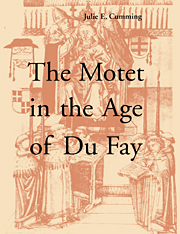Book contents
- Frontmatter
- Contents
- List of tables
- List of musical examples
- Acknowledgments
- Notes to the reader
- Introduction
- Part I Models and methods
- Part II Motets in the early fifteenth century: the case of Bologna Q15
- Part III Motets in the mid-fifteenth century: the case of the Trent Codices
- 8 Motets in the Trent Codices: establishing the boundaries
- 9 English and continental cantilena-style motets
- 10 Motets with a tenor cantus firmus c. 1430–1450
- 11 Freely composed four-voice writing in transition
- 12 The four-voice motet c. 1450–1475
- Conclusion
- Appendix: Widely disseminated motets
- Notes
- Bibliography of books and articles
- Modern editions of music
- Sources and sigla
- Notes on the index of works
- Abbreviations for subgenre identifications
- Index of works
- General index
9 - English and continental cantilena-style motets
Published online by Cambridge University Press: 22 September 2009
- Frontmatter
- Contents
- List of tables
- List of musical examples
- Acknowledgments
- Notes to the reader
- Introduction
- Part I Models and methods
- Part II Motets in the early fifteenth century: the case of Bologna Q15
- Part III Motets in the mid-fifteenth century: the case of the Trent Codices
- 8 Motets in the Trent Codices: establishing the boundaries
- 9 English and continental cantilena-style motets
- 10 Motets with a tenor cantus firmus c. 1430–1450
- 11 Freely composed four-voice writing in transition
- 12 The four-voice motet c. 1450–1475
- Conclusion
- Appendix: Widely disseminated motets
- Notes
- Bibliography of books and articles
- Modern editions of music
- Sources and sigla
- Notes on the index of works
- Abbreviations for subgenre identifications
- Index of works
- General index
Summary
The number of three-voice cantilena-style motets grew extensively during the 1430s and 1440s. In the 1450s their numbers declined as the four-voice motet achieved prominence: there are only six in the last two Trent Codices. I will therefore consider all the three-voice cantilena-style motets (early and late, English and continental) in this chapter.
The English cantilena: from Dunstaple and Power to Plummer and Frye
As a glance at Table 8.6 reveals, the English cantilena is far better represented than any other subgenre of the mid-fifteenth century (and this would be true even without the English section of Modena X.1.11, since most of its English cantilenas are concordant with TR+). In their catalog of English fifteenth-century sacred music Curtis and Wathey attempted a “rough chronological grouping,” with Band I including music “to the end of Dunstable's musical career,” and Band II including “music of the mid century, written by a subsequent generation of composers including Frye and Plummer.” In the case of anonymous works they presumably used style and manuscript dating as guides. I find the division helpful and revealing (see Table 9.1).
The earlier Band I group (Table 9.1.1, including music by Dunstaple, Power, Forest, and Piamor, as well as some anonymous pieces) is larger than the later Band II group (Table 9.1.2). Not only are there more Band I pieces (thirty-six) but most are found in multiple sources. Only ten are unica, and almost half are found in three or more manuscripts.
- Type
- Chapter
- Information
- The Motet in the Age of Du Fay , pp. 185 - 205Publisher: Cambridge University PressPrint publication year: 1999



